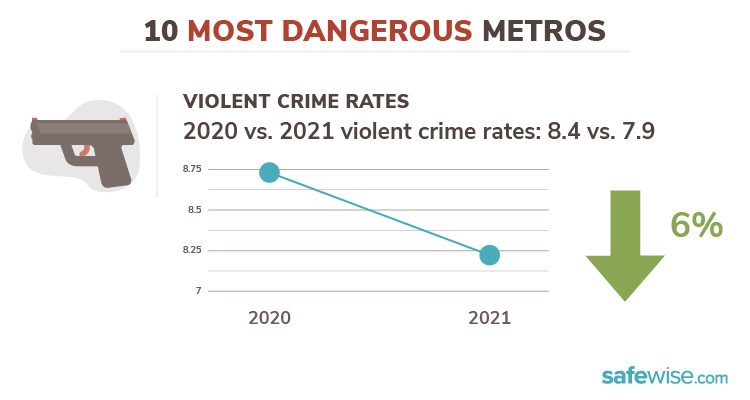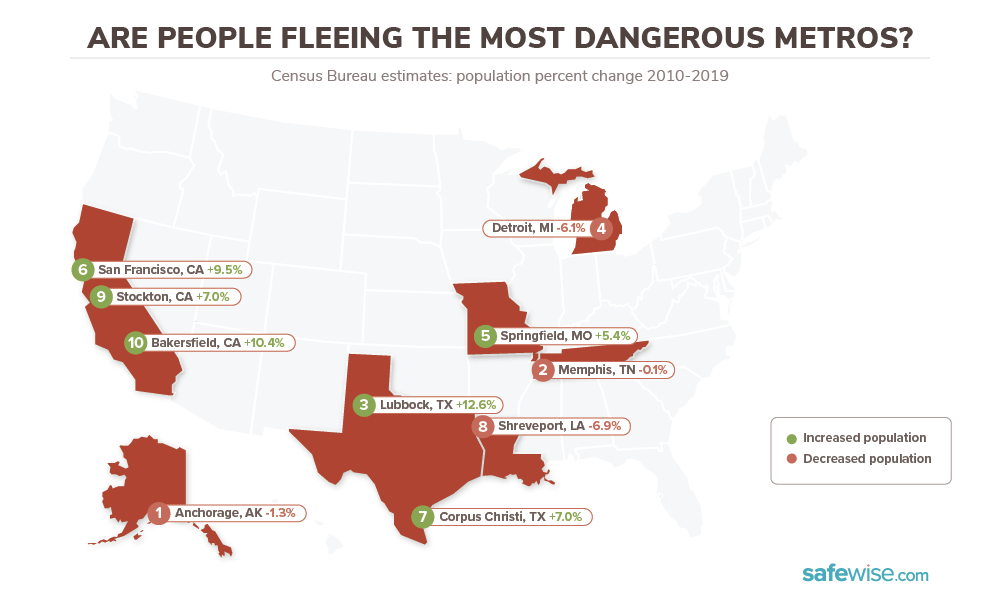10 Most Dangerous Cities in the US for 2021
Find out which metro areas reported the fewest crimes in our Safest Big Cities report.

Violent crime—especially gun violence—is nabbing headlines around the country, particularly in the country’s biggest cities. But which major metros report the highest numbers of crimes across the board?
To find out, we looked at the most recent FBI data for America’s major metro areas. And even though violent crime seems to be soaring in 2021 (so much so that The White House released a plan to attack the surge in gun violence), both violent and property crime rates fell year over year—even in the nation’s most dangerous big cities.
This gives us hope that this year’s headlines may signify more of a blip than a trend—especially if you look at the 10 metro areas that were ranked the safest in the US. Find out what the numbers mean in our full analysis of crime rates. We also explore crucial factors that impact life in the big US cities that report the most crime.
Take a deeper look at gun violence across the US—and how much Americans are worried about it—in our ongoing coverage that considers both the facts and the fears surrounding this important topic.
Here are the 10 most dangerous cities in the US for 2021
1. Anchorage, Alaska
2. Memphis, Tennessee Mississippi-Arkansas
3. Lubbock, Texas
4. Detroit-Dearborn-Livonia, Michigan
5. Springfield, Missouri
6. San Francisco-San Mateo-Redwood City, California
7. Corpus Christi, Texas
8. Shreveport-Bossier City, Louisiana
9. Stockton, California
10. Bakersfield, California
Learn more about every metro area that made our list
How these cities ranked most dangerous
When it comes to looking at crime rates and trends across the most populous areas of the US, we decided it made more sense to compare metropolitan statistical areas (MSAs) instead of standalone big cities. MSAs include both major “anchor” cities and the outlying communities that have high social and economic integration with the anchor city. So combining them paints a more accurate picture of both crime and the socioeconomic factors that impact the quality of life for residents.
To start with the most level playing field, we used FBI crime statistics to determine the rankings for the “most dangerous” metro areas in the country. This data isn’t perfect—it’s self-reported by law enforcement agencies each year—but it’s the most comprehensive US crime data available.
We looked at both property and violent crime, and we calculated the rate of each per 1,000 people. That’s where the ranking list comes from—if a metro area reported the highest weighted and normalized violent and property crime rates per 1,000 residents, it landed at the top of the “most dangerous” list. Those with lower crime rates fell to the bottom.
If a metro area didn’t submit a complete report to the FBI, or didn’t meet our population threshold of at least 300,000 people, it wasn’t considered for ranking.
Read our complete safest cities reporting methodology.
For the purposes of this report, the terms “safest” and “dangerous” refer explicitly to crime rates as calculated from FBI crime data—no other characterization of any community is implied or intended.
What it’s like to live in the most dangerous metro areas in America
Big-city life is fast paced, exciting, and full of challenges. More people, more problems (am I right?). We examined socioeconomic and lifestyle factors among the most dangerous cities in the US—like poverty rate, high school graduation rate, and median household income.
Here’s how the most dangerous metros measure up in some key areas:
People in these metros worry more about violent crime and property crime.

- People from the states that are home to the most dangerous metros are 8% more worried about crime and safety than the national average.

People in these metros are more likely to live below the poverty line.
- The percentage of people in the most dangerous metros who live below the poverty line is 27% higher than the US average.
Salaries in these metros are lower than the national average.
- On average, households in the most dangerous cities bring in nearly $20,000 less than households in the safest metro areas.
- San Francisco and Anchorage are the exceptions, with annual median household incomes of $130,000 and $80,000 respectively.
These metros spend less on public safety than the safest cities we ranked.
- The most dangerous metros spend around 15% less on public safety than the safest big cities.
These metros spend less on community services than the safest cities we ranked.
- The percentage of city budgets dedicated to community resources in the most dangerous metros is 58% lower than what’s allocated in the safest big cities.
These metros have fewer high school graduates than the average American city.
- The most dangerous metros have about 2.5% fewer high school grads than most US cities.
These metros have higher unemployment rates than the average American city.
- The average unemployment rate among the most dangerous metros (6.9%) is nearly two percentage points higher than in the safest metros (5.0%).
How has crime changed in the last year in the most dangerous metros?
Crime rates in both the safest and most dangerous metros saw bigger drops year over year than the nation did overall. During a time where homicides and gun violence seem to be on the rise, this is good news.
Year over year, the violent crime rate in the US held steady at 3.7 incidents per 1,000 people. But in the most dangerous metros, violent crime fell 6%, from 8.4 incidents per 1,000 to 7.9.

And property crime dropped even more. The most dangerous metros saw 11% fewer property crimes year over year—falling more than both the national average (down 4%) and the safest metros (down 9%).
Unfortunately, this year’s final crime numbers probably won’t turn out to be as encouraging, but there’s reason to celebrate lower crime rates (even in cities with higher crime numbers) in this year’s report.

Are people fleeing the most dangerous metros?
Higher crime rates don’t seem to be keeping people away from the metro areas that report the most crimes per capita. Only four of the cities on our list saw net drops in population between 2010 and 2019. And a full 60% of our list saw net gains that outpace the number of folks moving to the safest metro areas.

Interesting safest and most dangerous metro findings
Most dangerous metro area in America: Anchorage, AK
For the second year in a row, Anchorage, AK ranks as the most dangerous metro area in America. Here’s why it ranks first:
- In Anchorage, your risk of being a victim of a property crime is 1 in 23, based on the latest FBI crime data. Your risk of being a victim of violent crime is 1 in 84.
- By comparison, your risk of being the victim of a property crime in Rockingham County-Strafford County, NH (our safest metro), is 1 in 93. Your risk of being a victim of violent crime is 1 in 1,017.
State with the most dangerous metro areas: California
California has the most high-crime metro areas of any state, with 3 metros landing in our top 10 most dangerous (and all are new to our list this year):
- San Francisco-San Mateo-Redwood City, number 6
- Stockton, number 9
- Bakersfield, number 10
Metro area with the most murders: Detroit
Out of the top 10 most dangerous metros on our list, Detroit had the highest number of murder and non-negligent manslaughter incidents with 313.
- That’s more murders than in the top 10 safest metros combined (that grand total is 171—45% fewer than Detroit).
Grand theft auto: Many cars swiped in the most dangerous metros
Car theft was big business during the pandemic lockdowns in 2020. These metro areas were already ahead of the trend.
- 36,571 motor vehicle thefts were reported in the 10 most dangerous metros.
- Just 8,013 car thefts were reported in the 10 safest.
How to make a safe home anywhere
Whether your metro area made our list or not, we encourage everyone to be proactive about protecting your home and family. One of the best ways to stop a burglary before it happens is to add a home security system.
We found the best home security options for nearly every budget, including self-monitored systems with no monthly fees and professionally monitored systems starting as low as $10 per month.
Learn more about your home security options—and find out which companies we recommend for every budget and lifestyle in our roundup of the Best Home Security Systems.
Find the Safest Cities in each state
Click on the state image below to check out the safest cities for each state—and find out how people in your state feel about crime and safety in our State of Safety report.
- Alaska
- Alabama
- Arkansas
- Arizona
- California
- Colorado
- Connecticut
- Delaware
- Florida
- Georgia
- Hawaii
- Iowa
- Idaho
- Illinois
- Indiana
- Kansas
- Kentucky
- Louisiana
- Massachusetts
- Maryland
- Maine
- Michigan
- Minnesota
- Missouri
- Mississippi
- Montana
- North Carolina
- North Dakota
- Nebraska
- New Hampshire
- New Jersey
- New Mexico
- Nevada
- New York
- Ohio
- Oklahoma
- Oregon
- Pennsylvania
- Rhode Island
- South Carolina
- South Dakota
- Tennessee
- Texas
- Utah
- Virginia
- Vermont
- Washington
- Wisconsin
- West Virginia
- Wyoming
Related reports on SafeWise
Endnotes
1. Median income, poverty line, and high school graduation statistics
US Census Bureau (2018), “American Community Survey 1-year estimates,” Retrieved from Census Reporter Profile page for each metro area. Accessed August 2, 2021.
2. Unemployment rates
US Bureau of Labor Statistics, “Local Area Unemployment Statistics, Unemployment Rates for Metropolitan Areas, Annual Averages,” June 2021. Accessed August 2, 2021.
3. City budget allocations
Note: In most cases, data represented is for the most populous city within the metro area. We selected the largest city within the area as a representative sample of the entire metro area and refer to these as “anchor” cities.
Anchorage, Alaska, “General Government Operating Budget,” Retrieved from page 2. Accessed August 2, 2021.
City of Memphis, “FY 2021 Adopted Operating Budget,” Retrieved from pages 63 and 64. Accessed July 13, 2021.
City of Lubbock, Texas, “Adopted Operating Budget & Capital Program FY20–21,” Retrieved from page 31. Accessed July 13, 2021.
Detroit, Michigan, “FY 2020–2021 Adopted Budget,” Accessed July 13, 2021.
City of Springfield, “FY 2020–2021 Adopted Annual Budget,” Retrieved from pages 51 and 217. Accessed July 13, 2021.
City and County of San Francisco, California, “Proposed Budget Fiscal Years 2021–2022 and 2022–2023,” Retrieved from page 11. Accessed July 13, 2021.
City of Corpus Christi, “2020–2021 Proposed Operating Budget,” Retrieved from page 29. Accessed July 13, 2021.
City of Shreveport, “2021 Annual Operating Budget,” Retrieved from page 8. Accessed July 13, 2021.
City of Stockton “FY 2020–21 Annual Budget,” Retrieved from page 8. Accessed July 13, 2021.
City of Bakersfield, CA, “Open Budget, Expenditures 2022,” Accessed July 13, 2021.
Recent Articles




The post 10 Most Dangerous Cities in the US for 2021 appeared first on SafeWise.
Article source here: 10 Most Dangerous Cities in the US for 2021
